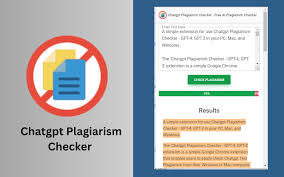Introduction
Information is readily available in the current digital era, and creating material has become commonplace. The uniqueness of your material is important whether you’re a professional writing reports, a blogger publishing articles, or a student writing an academic paper. A plagiarism checker is one tool that is essential to preserving the integrity of written content. This technology guarantees that every piece of writing is genuine and appropriately attributed while also assisting in the detection of copied work.
What is a Plagiarism Checker?
A plagiarism checker is a computer program or application that scans text and compares it to a large database of websites, scholarly publications, articles, and other materials. Finding any parallels or precise matches between the submitted content and pre-existing sources is the goal. The program usually indicates the copied passages and gives the original source when it detects duplicate content.To maintain originality and prevent intellectual property theft, academic institutions, publishing houses, content marketing companies, and enterprises all utilize plagiarism checkers extensively.
The Importance of Using a Plagiarism Checker
Maintains Academic Integrity
Plagiarism is a major infraction in educational institutions. Students who turn in work that has been plagiarized risk serious repercussions, such as poor marks, suspension, or expulsion. Plagiarism checkers are used by instructors and educational institutions to ensure that students have turned in original work with accurate citations. These resources support academic standards and provide a fair assessment of students’ work.
Boosts Content Credibility
Originality is crucial in digital publishing and content marketing. A website’s credibility can be harmed by plagiarism, which can also lower its search engine ranks. Websites with duplicate content are penalized by search engines such as Google. Before publishing, content producers can make the required changes and confirm that their articles, blogs, or web pages are original by employing a plagiarism checker.
See more article: plagiatsprüfer
Protects Intellectual Property
Writers, researchers, and creators invest time and effort into producing original work. A plagiarism checker can help protect their intellectual property by alerting them to unauthorized use or reproduction of their content elsewhere online. This tool helps maintain ownership and ensures due credit is given where it’s deserved.
Improves Writing and Research Skills
Using a plagiarism checker encourages writers to paraphrase effectively, cite sources correctly, and engage in deeper research. Over time, this fosters better writing habits and improves academic or professional writing skills. Students, in particular, learn the value of originality and the consequences of copying someone else’s ideas.
How Does a Plagiarism Checker Work?
- AI-based technology and intricate algorithms are used by plagiarism checkers. This is an explanation of how it usually operates:
- Text Submission: The content to be reviewed is uploaded or pasted by the user.
- Data Comparison: After scanning the text, the program compares it to a sizable database of published works, including books, research papers, articles, and other online materials.
- Similarity Detection: The program determines a percentage of similarity by finding phrases, sentences, or paragraphs that match.
- Report Generation: A thorough report that highlights redundant information and includes links to the original sources is produced. Additionally, several systems provide recommendations for correct citation or rewriting.
- Qualities to Consider in an Effective Plagiarism Detector
- Not every plagiarism detector is made equally. Take into account the following characteristics when choosing the appropriate tool:
- Entire Database:
- Accuracy: It should detect both exact matches and paraphrased content effectively.
- User-Friendly Interface: A simple and intuitive layout makes it easier to use.
- Speed: The tool should be able to deliver results quickly, especially for large documents.
- Citation Support: Good checkers not only flag issues but also provide citation suggestions in formats like APA, MLA, or Chicago.
- Privacy Protection: Ensure the tool does not store or reuse your content.
Popular Plagiarism Checkers in Use
Several reliable plagiarism checkers are available today. Here are a few of the most widely used:
- Turnitin: Commonly used by educational institutions, it is known for its accuracy and integration with academic databases.
- Grammarly: Besides grammar checking, Grammarly also offers a plagiarism detection feature that compares your text to billions of web pages.
- Quetext: a well-liked writing and blogging tool with both free and paid editions.
- Website owners mostly utilize Copyscape to find duplicate content online.
- Researchers and academics trust Plagscan because it provides thorough scanning of scientific publications.
- What Happens If You Don’t Use a Plagiarism Checker
- The repercussions of not using a plagiarism checker can be dire. These consist of:
- Legal Concerns: Legal action and financial penalties may result from copyright violations.
- Damaged Reputation: When people or organizations are detected plagiarizing, their credibility may be permanently harmed.
- Academic Penalties: Students may be subject to expulsion or failing grades, among other disciplinary measures.
- Loss of Career Opportunities: Plagiarism can cost you your job or future employment opportunities in the workplace.
Tips to Avoid Plagiarism
While plagiarism checkers are invaluable, it’s equally important to develop habits that reduce the risk of unintentional plagiarism:
- Get a thorough understanding of the topic so that you can explain it in your own words.
- Take Proper Notes: Keep a record of every source you consulted while conducting your research.
- Carefully paraphrase: Instead of just replacing a few words, reorganize the statement while preserving its original meaning.
- Employ Quotation Marks: When directly quoting, always use quotation marks and provide credit to the original source.
- Cite All Sources: When paraphrasing or quoting, always give due acknowledgment.
Final Thoughts
In an age where digital content is produced and shared at an unprecedented scale, ensuring originality is not just important—it’s essential. A plagiarism checker acts as a guardian of authenticity, protecting creators, students, and professionals from the pitfalls of accidental or deliberate duplication.You can protect your writing and foster a culture of honesty, originality, and respect for intellectual property by integrating a trustworthy plagiarism detection technology into your writing process.
For more and latest article: Clicking Here

